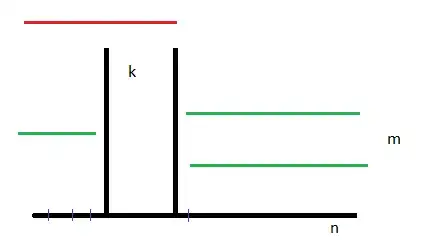Let us use a discreet version of the problem and then solve it with the limit

We will count the number of cases when the full coloring happened exactly after $M^{th}$ attempt.
To simplify the reasoning, we will use the equivalent linear version of the problem. We cover a line(circumference of the disk) of length $l$, with lines of length $\frac{l}{2}$. The line is actually a representation of the circle so the end of it is connected to the beginning, meaning a gap, for example, can spill over.
First, we divide a line in $n$ segments.
In the picture, we have $m$ attempts that have created a gap of $k > 0$ segments in length. (On the disk, this would correspond to the uncolored angle $\frac{k2\pi}{n}$.)
In the end, at exactly the $m+1^{th}$ attempt, $m+1=M$, we have managed to color the entire disk. (This is the red-line attempt in the picture.)
In total, we have $n^{m+1}$ possible outcomes.
In order to create a gap of size $k$, we need two attempts, two half lines, that will neighbor the gap to the left and to the right. For this we need two attempts and this has $m(m-1)$ different possible selections out of $m$ attempts.
Next, a half line can fit into the remaining non-colored region in $\frac{n}{2}-k$ ways, and since we have $m-2$ attempts, that means that we have $(\frac{n}{2}-k)^{m-2}$ possible variants.
One more, since we want to cover the gap at the very end by another half line, we can do this in $\frac{n}{2}-k$ ways.
Not to forget, each gap can be positioned in $n$ different location around the circle (line in the picture).
So the total expression of probability of covering the entire line (circumference of the disk) exactly after the $M^{th}$, $M=m+1$, attempt, where we had a gap of size $k$ before the last draw is:
$$\frac{n \cdot m(m-1)(\frac{n}{2}-k)(\frac{n}{2}-k)^{m-2}}{n^{m+1}}$$
For all possible gaps this is:
$$ \sum_{k=1}^{\frac{n}{2}} \frac{m(m-1)(\frac{1}{2}-\frac{k}{n})^{m-1}}{n}$$
and now we let $n$ to tend to infinity
$$ p(m) = \lim_{n \to \infty} \sum_{k=1}^{\frac{n}{2}} \frac{m(m-1)(\frac{1}{2}-\frac{k}{n})^{m-1}}{n}$$
Maybe not trivial, but not impossible either, we reach:
$$ p(m) = \frac{m-1}{2^m} $$
or
$$ p(M) = \frac{M-2}{2^{M-1}} $$
Adding to the flavor, the expected value of the number of strokes before we paint the entire disk is:
$$ E(M) = \sum_{k=1}^{\infty}p(M) = 0+0+ \sum_{k=3}^{\infty}M\frac{M-2}{2^{M-1}} = 5$$
